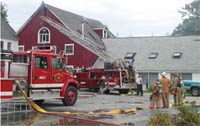
A Close Call
New addressable fire alarm system saves historic inn
- By Megan Weadock
- Dec 01, 2008
 A historic landmark is much like a
piece of art. It reveals something
about us and our past, and it must
be protected and preserved as if it were
priceless. That’s why the threat of fire is one
of the top concerns for owners and operators
of the nation’s historic landmarks.
A historic landmark is much like a
piece of art. It reveals something
about us and our past, and it must
be protected and preserved as if it were
priceless. That’s why the threat of fire is one
of the top concerns for owners and operators
of the nation’s historic landmarks.
“Imagine the loss of an irreplaceable
historic site,” said Nick Martello, director
of marketing for Fire-Lite Alarms. “It’s
just not the same if it’s rebuilt. Once a fire
begins, it can ravage a building in seconds,
not minutes. That’s why smoke
detection is so important. Once a fire
starts, we know almost immediately.”
Old Meets New
Revamped from a farmhouse built in
1850, the Inn at Danbury is exactly the
type of historic landmark that must be
protected and preserved. The inn, located
in a scenic rural area of central New
Hampshire, features 14 guest rooms, an
indoor pool and the award-winning
Alphorn Bistro restaurant. A family of six
runs the inn, which is famous for its combination
of old-world German hospitality
and New England charm.
Last year, the Danbury fire chief,
Thomas Austin, determined that the inn
needed a new fire alarm system throughout
the restaurant, barn and guest quarters.
Although several companies offered
bids consisting of less sophisticated, conventional
systems, the owners of the inn
wanted a much higher level of protection.
In the end, they chose Fire-Lite, which
completed the installation of an addressable
MS-9050UD system by mid-
November 2007.
The MS-9050UD features advanced
detection and point identification capabilities.
Remote upload/download programming,
notification appliance circuit synchronization
and detector/module autoconfiguration
made the system easy to
install and maintain.
Just in Time
On Aug. 15, a four-alarm fire broke out in
the three-story barn, threatening the
attached inn and restaurant. The Fire-Lite
MS-9050UD addressable fire alarm system
detected smoke and notified fire and
police a full five minutes before the first
phone call was made from the premises to
report the fire.
“The system detected smoke, which
triggered an immediate alarm within the
building,” said Beth Welch, public relations
manager for Honeywell Fire Systems.
“Simultaneously, the fire alarm system
sent an alarm to the central station, which
sent the emergency responders rolling
toward the inn. The innkeeper heard the
alarm and went to investigate, finding only
smoke. Soon thereafter fire erupted,
engulfing the top floor of the barn.”
Martello explained that the Fire-Lite
system senses the changes caused by
smoke and heat within just a few moments.
“Once the panel ‘sees’ the level change
from the specific address of the detector
in alarm and goes into alarm mode, the
notification appliance circuits activate,
sending voltage to horns and strobes for a
local audio/visual alarm, the panel displays
a text description of the alarm point
and the system’s communicator automatically
dials the central station with the
coded alarm,” he said. “This whole
process takes place in mere seconds.”
Back on Track
The fire drew firefighters from nearly 20
area departments. In the end, the barn
only suffered water and smoke damage,
and the inn and restaurant were left
unscathed.
“Had it been five more minutes, the
inn would have suffered total devastation,”
Austin said. “I can’t compliment the
alarm system enough. If it hadn’t worked,
they might not have realized the situation
until it was too late.”
After the fire, the Inn at Danbury’s fire
alarm system was restored and put back
into commission within 48 hours.
According to the inn’s Web site, both the
inn and restaurant are once again operating
as normal.
This article originally appeared in the issue of .
About the Author
Megan Weadock is a communications specialist at Monitronics.